Asus ROG Poseidon GeForce GTX 1080 Ti 11GB Platinum Edition Review
Why you can trust Tom's Hardware
Temperatures & Clock Rates
Overclocking
Overclocking the ROG Poseidon GeForce GTX 1080 Ti under air cooling is pointless, for the most part. Asus tunes this board aggressively straight from the factory, leaving little headroom available for higher frequencies. Especially in a closed computer case, the card is already at its physical limits.
With sufficient water cooling, however, we were able to reach 2076 MHz. That's where our chip hit its ceiling, even after installing a high-end loop, increasing the power target, and applying a bit of extra voltage.
Temperatures & Clock Frequencies
The following table includes starting and end values for our temperature and GPU Boost clock rates.
| Header Cell - Column 0 | Start Value | End Value |
|---|---|---|
| Open Test Bench | ||
| GPU Temperature (Air Cooling) | 40°C | 76°C |
| GPU Frequency (Open Bench) | 2012 MHz | 1924 MHz |
| Ambient Temperature | 22°C | 22°C |
| Closed Case | ||
| GPU Temperature (Air Cooling) | 42°C | 78°C |
| GPU Frequency (Closed Case) | 2000 MHz | 1898 MHz |
| Temperature Inside Case | 25°C | 38°C |
| Water Cooling | ||
| GPU Temperatures (Stock) | 22°C | 35°C |
| GPU Frequency (Stock) | 2025 MHz | 2000 MHz |
| GPU Temperatures (Maximum O/C) | 22°C | 37°C |
| GPU Frequency (Maximum O/C) | 2076 MHz | 2076 MHz |
| Water Temperature | 20°C | 20°C |
Temperatures vs. Frequency
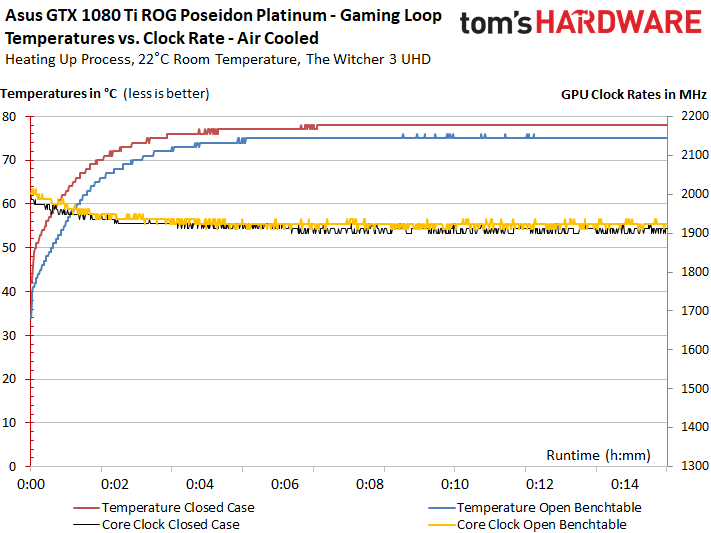
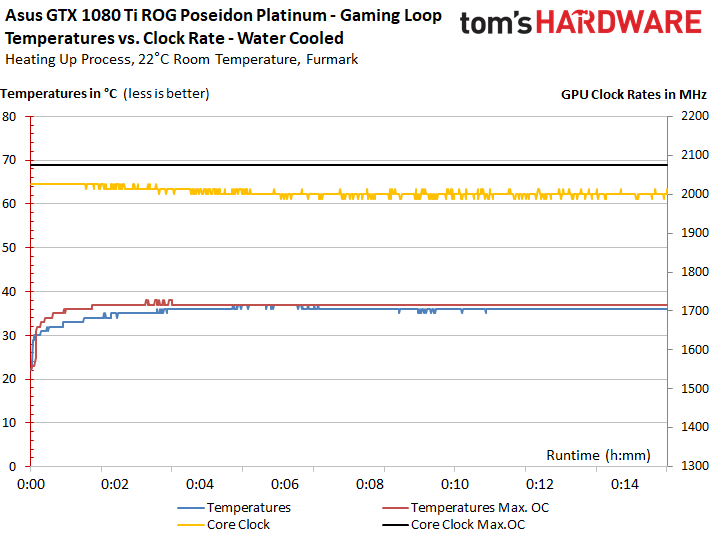
Here's a closer look at the data over 15 minutes, during our sample's warm-up phase.
Infrared Temperature Analysis
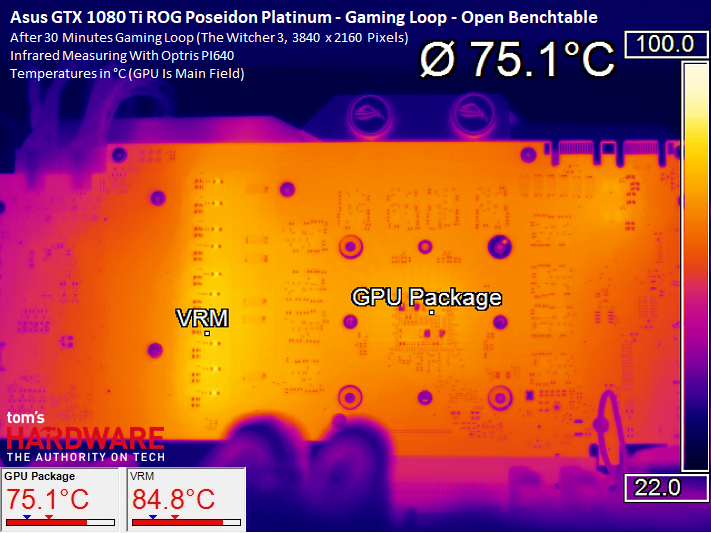

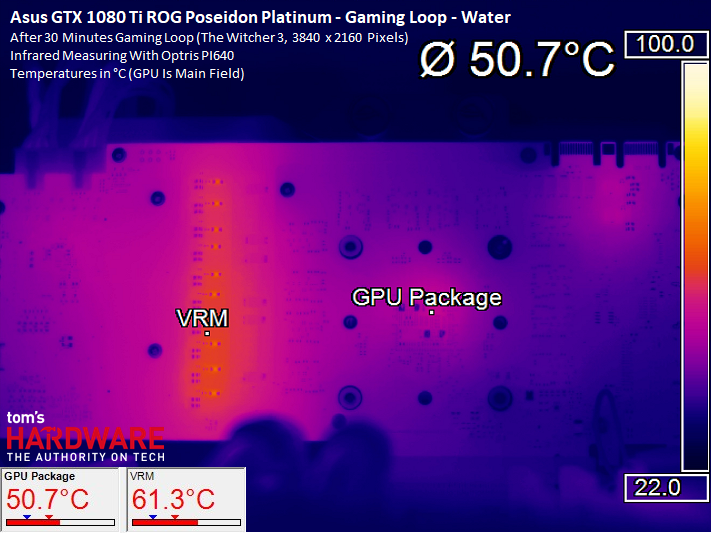
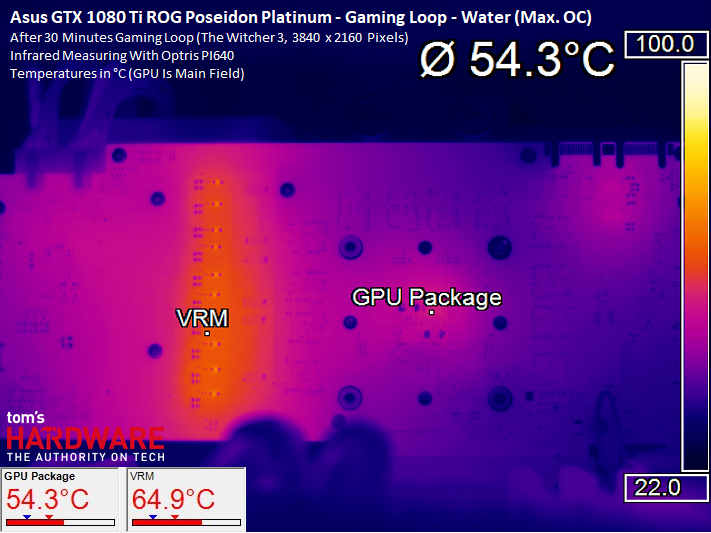
Under the effects of air cooling, our measurements at the GPU package and the chip's own reported values appear identical, since thermal energy dissipates more slowly.
Using water cooling, however, reveals a minor weakness in Asus' solution. Whereas a full-coverage water block wouldn't allow a difference of more than 5 Kelvin between the liquid and GPU diode, this hybrid implementation shows a gap of up to 17 Kelvin in our overclocked scenario. Moreover, the board temperature below the GPU package is also significantly higher than what Nvidia's GP102 reports.
MORE: Best Graphics Cards
Get Tom's Hardware's best news and in-depth reviews, straight to your inbox.
MORE: Desktop GPU Performance Hierarchy Table
MORE: All Graphics Content

Igor Wallossek wrote a wide variety of hardware articles for Tom's Hardware, with a strong focus on technical analysis and in-depth reviews. His contributions have spanned a broad spectrum of PC components, including GPUs, CPUs, workstations, and PC builds. His insightful articles provide readers with detailed knowledge to make informed decisions in the ever-evolving tech landscape
-
Pat Flynn I wonder how their cooler compares to something like EKWB's blocks? Temps/overclock wise that is.Reply -
dan88rx7turbo I have the Poseidon , sits at about 43c on load in Valley and Superposition 4k , 1080p extreme settings!Reply -
JackNaylorPE 1. The Poseidon is a great idea in concept but suffers from poor implementation.Reply
2. The addition of the PCB parts is a welcome addition. However w/o an explanation of how they differ from reference cards or compare to other AIB cards, it inda falls flat.
3. Benchmark Comparisons w/ just the reference model again leaves me wanting more. Asus Strix would at least allow comparisons to other AIB cards
.
4. And yes .... would have been very useful to compare against other options. An EVGA Hybrid and say the MSI Seahawk EK X (w/ full cover EK water block) would also be a big plus.
-
drmacaron i also have a poseidon. Super good temp dont know why the warer development aded maby if you should clocke it bigtime ?Reply -
mac_angel I have the Asus Strix 1080ti OC. It 'boosts' to 2Ghz on it's own. But playing with the curve in Afterburner, I get 2076MHz, on air. That's without flashing the ROMReply -
JackNaylorPE Reply20192947 said:I have the Asus Strix 1080ti OC. It 'boosts' to 2Ghz on it's own. But playing with the curve in Afterburner, I get 2076MHz, on air. That's without flashing the ROM
The OC is be expected ... from the article :
With sufficient water cooling, however, we were able to reach 2076 MHz. That's where our chip hit its ceiling, even after installing a high-end loop, increasing the power target, and applying a bit of extra voltage.
But outta the box, the boost is down at 1708 / 1709
http://www.tomshardware.com/reviews/asus-rog-poseidon-gtx-1080-ti-platinum,5151.html
-
Rheotome Both of these statements are incorrect:Reply
"lay down a flat heat pipe on a large sink and, as an option, send water through to dissipate thermal energy"
"The thermal solution utilizes a copper sink that doubles as a block for water cooling (by guiding liquid through the hollow heat pipe). "
No water flows through a heat pipe. A heat pipe is hollow, closed and sealed to contain the working fluid that evaporates and condenses to transfer heat from a hot to cold point.
The author is confusing heat exchanger and heat pipe technology. -
JackNaylorPE Actually, no ... there is no air involved in a heat exhangerReply
"A heat exchanger is a device used to transfer heat between a solid object and a fluid, or between two or more fluids."
The proper term here would simply "radiator tube" under normal circumstances ... as it is employed here, it's simply part of a hybrid water block, heat sink / radiator.